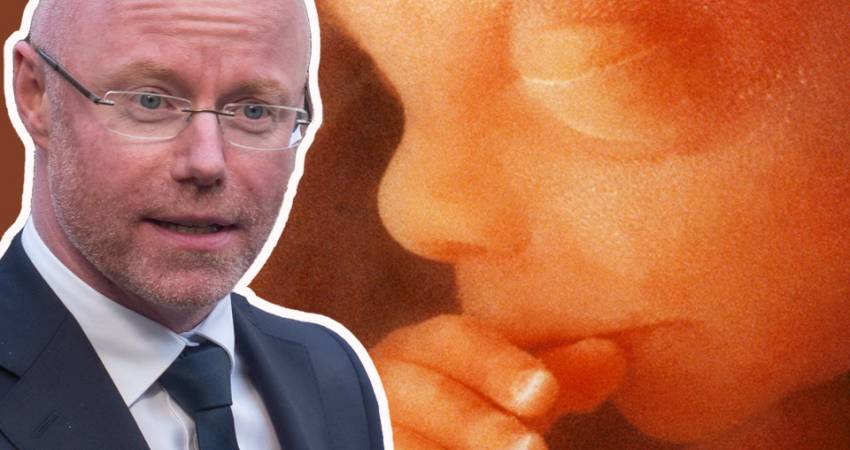
3 fatal flaws in the Abortion Review that the media ignored
As has been previously established, the long-awaited review of the 2018 abortion legislation was stacked in one direction from the beginning. But it is still astonishing to see the media ignore the fatal flaws in what was purported to be an independent examination of the operation of the abortion act.
It is very unlikely that the ever-shameless Stephen Donnelly (and his predecessor, the equally useless Minister for Health, Simon Harris) ever wanted an actual critique of the shocking outcomes of Ireland’s abortion laws.
So it was no surprise that the report issued by barrister Marie O’Shea amounted to 138 pages of pro-abortion talking points. The many negative outcomes of the legislation were largely ignored.
Most at fault in this grand choreographed dance which is, in effect, keeping voters in the dark, are the journalists and news editors who chose to turn a blind eye to the abortion outcomes which they know would cause public disquiet.
So they endlessly repeat the nonsensical claim that abortion isn’t accessible when the number of babies whose lives have been ended have gone through the roof – with Stephen Donnelly recently trumpeting a figure of 8,500 abortions for 2022 alone.
8,500 abortions is a tragedy, Minister, not a boast. No reasonable person thinks a 25% jump in abortions in a year is a good thing. Yet that perspective is effectively censored in all discussions around the issue, and so the numbers continue to inexorably rise.
The media also contrives to ignore the evidence that the 3-day wait saves lives, as if data from the HSE is irrelevant – and fails to explore the profoundly disturbing revelations that babies are being born alive after abortions in Ireland.
Pro-life commentators are mostly excluded from any broadcast discussions – and if they are included they are usually outnumbered or shouted down.
Pro-abortion groups, on the other hand, are treated with the kind of deference that used to be reserved for oracles, and every utterance is accepted as gospel.
This contrivance is a recognised form of media bias, by the way. Amongst the categories which are commonly used in assessing media bias internationally are: bias by selection or omission; and bias by source. Most of the Irish media make up a massive collective failure on this front.
Consider the repeated reporting of the untrue claim that women are being harassed and intimidated while seeking abortions at Limerick hospital. Gary Kavanagh’s investigation demolished that claim, because he did the job a journalist is supposed to do – he uncovered the facts and looked at the evidence.
The reality is that most of the Irish media are happy to simply act as slavish mouthpieces for abortion campaigners.
If they had been doing their job, here’s 3 fatal flaws in the abortion review that they should have highlighted.
1. HSE DATA THAT SHOWED 3-DAY WAIT REDUCES ABORTIONS STRANGELY ABSENT
There’s data, and then there’s cherry-picked data that is used to conveniently bolster one side of the argument or to avoid showing the full picture.
Since 2019, figures provided to TDs like Carol Nolan showed that thousands of women who attend their first appointment did not return after the 3-day period of reflection to actually undergo an abortion. The data provided by the HSE has been examined by statistician Jim Stack.
Stack says that the HSE data puts the percentage of women who DON’T return for an abortion at 20% in 2021 “when 1,601 out of 8,284 initial consultations did not end in abortion”.
He also notes that “the Abortion Review Report .. puts this figure at just 2%, based on a single study.”
That study is a 2019 piece of research whose authors include abortion-supporting doctors, many of whom took part in the Repeal campaign, and who continue to press for an even more liberal abortion law.
Specifically, at least four of the doctors are now campaigning to have the three-day wait removed. One of them, Dr Mark Murphy, is thanked for his help in compiling the Abortion Review by its lead, Marie O’Shea.
No conflict of interest at all there, I suppose.
Stack notes that the figure of 2% of women changing their minds is not backed up by other findings. He notes that “in the same year, 2019, the Irish Family Planning Association in its annual report said that “12% of clients did not continue through our abortion service” – and that “the IFPA figures for 2021, presented in a recent Irish Times article by Kitty Holland, were as follows: 48 out of 484 clients did not continue through, which is 9.9%.”
“The author of the Abortion Review Report speculates that some women may be booking initial appointments with more than one provider. That would have to be happening on a massive scale to account for the discrepancies noted above. As PPS numbers have to be provided to claim payment for the initial consultation [to abortion providers], this hypothesis could easily be checked,” he writes.
Stack has also shown that the huge numbers who do not return for abortion after the 3-day wait cannot be explained by miscarriage.
So the Abortion Review ignored other findings from other studies – even when they were authored from abortion supporters – that suggested substantial numbers of women don’t go through with abortion during the 3-day wait. That seems peculiar.
In fact, it is utterly inexplicable that a supposedly independent review would actually ignore the HSE’s own data showing that thousands of women did not return for an abortion after the 3-day period. Is looks like cherry-picking – only using data that bolsters your claim.
During 2019 to 2022, that data from the HSE shows that almost 4,000 women did not return after the 3-day wait – and further, the HSE data is nationally representative: it includes all the first appointments and all the subsequent abortions each year.
Yet Marie O’Shea’s review is curiously uninterested in these numbers, and focuses instead on a study with a far-smaller sample size which was conducted by abortion supporters.
And so the stage is set.
Then the same media who roundly ignored the HSE data for years, have the opportunity to lead with headlines about “just 2% of women” changing their minds about abortion – and follow with demands of abortion supporters pushing to scrap the 3-day wait. It’s all very convenient, isn’t it?
It’s also shameful. Ignoring the most relevant data on the 3-day wait is a fatal flaw in the Abortion Review. But failing to challenge that decision is the fault of the media alone.
2. TURNING A BLIND EYE TO THE ONGOING SCANDAL OF BABIES ABORTED AFTER A MISDIAGNOSIS
The ink had barely dried on the abortion legislation when a catastrophic error at the National Maternity Hospital happened which should have led to a root-and-branch review of the culture in Irish maternal healthcare around abortion.
An unborn baby boy was misdiagnosed with Trisomy 18. His parents were told that there was “no hope” and an abortion was carried out when the baby, a little boy they named Christopher, was 16 weeks gestation.
After the abortion, the final results of the test came back and the baby was found to be perfectly healthy, but by then it was too late. His parents, who have successfully sued the NMH in the High Court, are still fighting for a satisfactory inquiry into what happened.
While the government continues to drag its heels on the Baby Christopher case, new information released to Peadar Tóibín TD shows that the State is currently being sued in two ongoing cases of a wrongful diagnosis in relation to the abortion act.
Vicky Wall of Every Life Counts, a support network for families where an unborn baby has been diagnosed with a life-limiting condition, has urged a full review of how the culture in maternity hospitals may be pushing parents towards abortion.
“This is an absolute bombshell. It is almost unbelievable that we are hearing of two more babies that have been aborted in this way,” she said. “Where is the inquiry, and the media headlines? Why isn’t the HSE and the Minister being held to account.”
The Abortion Review, one would imagine, would be an ideal vehicle to examine these horrendous cases, yet Marie O’Shea remained absolutely silent in this regard.
This is a fatal flaw. If a review of abortion provision in Ireland chooses to ignore an enormously high-profile case of abortion after a misdiagnosis, then it is worse than useless.
Yet, not one journalist across the establishment media in Ireland thought to challenge this omission.
3. FAILURE TO ADDRESS THE SHOCKING RISE IN THE NUMBER OF ABORTIONS
In the first year of legalised abortion in Ireland, 6,666 abortions took place. In 2020, despite the Covid lockdowns, there were 6,577 recorded abortions, and another 6,700 approximately in 2021 – though the Department of Health isn’t entirely sure about that year, but that doesn’t seem to matter to the Minister.
Those numbers were already a huge increase on the 2,879 women who had travelled to Britain from Ireland for abortion in 2018 – with perhaps another 1,000 taking an abortion pill.
But now Stephen Donnelly is telling RTE – as evidence that abortion provision is in fine fettle – that 8,500 abortions took place in 2022, an enormous jump of 25% on the previous year.
That would be in excess of 28,000 abortions over 4 years. It’s more people than the population of Kilkenny city, all gone, all snuffed out before they were even born.
Yet the Abortion Review has nothing to say about rocketing abortion rates – nor does it examine any proposals to try to decrease the number of abortions.
Instead, there are demands that the government target pro-life doctors, and suggestions that the law be broadened and safeguards removed.
These are just three of the reasons the Abortion Review is fatally flawed. There are others, but don’t expect Ireland’s wholly biased, utterly partisan, media to inform you about any of them.
This piece was first published on Gript.
Featured
- Campaign to stop EU funding out of state abortions - tell your EU commissioner to vote NO
- Judge recuses himself from case of woman praying in censorship zones for “apparent bias”
- I’m a Celebrity star criticises “sad” UK law that aborts babies with Down Syndrome up to birth
- British actress speaks out on “serious risk” assisted suicide bill has for those with eating disorders
- Caplan’s “Tragic Hysteria of Abortion” discusses the flaws with mainstream Turnaway Study interpretations
- Backlash as Scotland report proposes legalising sex-selective abortion up to birth
- Canada hits new record as 1 in 20 deaths a result of Euthanasia
- Ben Scallan defends pro-life on TV show Dinner with the Enemy
- Influencers share the loss of their beloved unborn baby
- Dublin woman with cancer says unborn child was sent to save her
- Mother and baby doing well after surgery for mother’s cancer during pregnancy
- Josiah: Abortion Survivor
- Loving the Unborn
- Rally for Life 2025
- Don't assist Suicide 2024


























